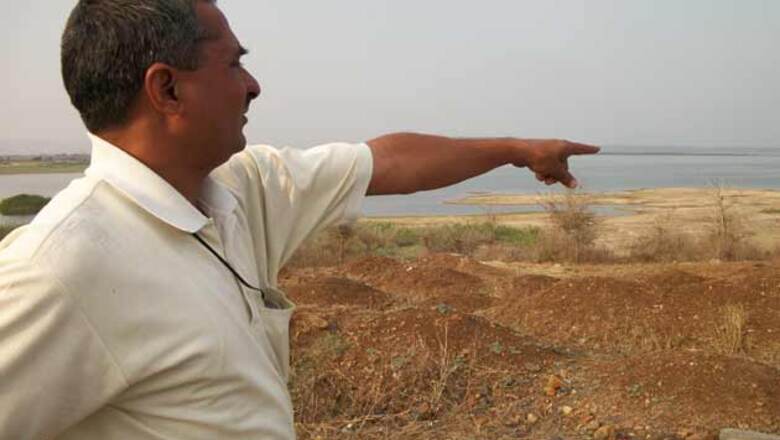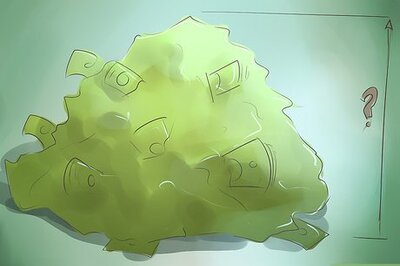
views
The seemingly placid waters in the Upper Wardha Dam betray the simmering undercurrent of an agrarian unrest.
The resentment is so strong that in Gandhi’s adopted home - Wardha - farmers have decided to shed the path of non-violence. The angst literally spilled over the dam reservoir in March this year (2010) with 400 farmers deciding to take law into their own hands over their right to dam water.
Taking local authorities by surprise they - mostly small and medium land holders - raided and razed to ground a pumping station being set up to supply water to the Indiabulls Thermal Power Plant at Nandagaonpeth in Amravati District.
The state government has allocated 87 million cubic meter or Mm3 of water per anumn from the dam’s catchment area to the under construction 2640 Mega Watt energy station.
Farmer’s are up in arms; fearing diversion from the 302 Mm3 of water exclusively reserved for irrigating 75,000 hectares of land. They are mobilizing support under the banner of 'Upper Wardha Pani Bachao Samiti'.
The dam reservoir has an estimated live stock of 548 Mm3; and the Right and the Left Bank canals emanating at the dike are the only major source of irrigation in eight 'talukas' of Wardha and Amravati districts of the drought battered and water starved western Vidarbha region.
“For us, it’s a question of life and death. Thousands have perished here during the last decades of agrarian distress. If the government doesn’t relent, many amongst us are prepared to commit suicide by jumping into the dam reservoir”; says Sanjay Kolhe of Naya Vathoda village.
How much water is there anyway
From an inconspicuous ground-floor apartment in Amravati’s relatively well-off neighbourhood Dr Sharad Kinkar coordinates perhaps the most challenging assignment of his bureaucratic career. On him rides Rs 7, 000 crores of capital. The former Amravati collector now heads the Indiabulls operations in the district. It is his responsibility to oversee a hassle free implementation of the power project.
“It is a win-win situation for all. And there is no dearth of water, there is sufficient water for both the industry and well as for the agriculture”; explains Kinkar.
The company argues that even after allocating stipulated water for irrigation, drinking and another 87 mm3 for the Indiabulls power project, nearly 13 per cent of the live storage remains un-utilized.
Someshwar Pusapakar, former president of the city unit of the Shiv Sena now campaigning against the power plant disagrees.
“These figures are misleading”; he argues. “You are discounting 90 Mm3 lost due to evaporation. The net water available is less than 500 Mm3 and not 548 mm3. Vidarbha Irrigation Corporation in its April, 2009 report explicitly states that”
Pusapkar also sites a high powered state Group of Minister’s or GoM report. “This committee while giving clearance to the project clearly maintains 23,211 hectares of irrigation is to be affected if water is allocated for the project”; he says.
Besides, Indiabullls is not the only company in queue to set up thermal plant in the district. In the pipeline is Amravati Thermal Power Company seeking 38 Mm3 water from the Upper Wardha Dam Reservoir for its 1320 MW plant at Nandgaonpeth.
Death and distress
Kidneys for 50 lakhs: proclaims the billboard right at the gates of Shivni Rasulapur village on the busy highway connecting Amravati and Wardha.
By putting a price tag on their organs, the villagers had hit upon an ingenious campaign of shaking the state out of slumber. To their disappointment and dismay, the shock and awe technique seems to have had very little impact. Farmer suicides continue unabated in the last ten years in six worst affected districts of agrarian distress in central India including Amravati and Waradha.
Prime Minister Manmohan Singh while announcing special relief packages for these areas in 2006 had emphasized on the need to expand irrigation footprint.
“There is a crying demand all around for improving irrigation. We are allocating Rs.2177 crores from the Central Government for completion of major, medium and minor irrigation projects in these districts over the next 3 years”; reads a statement released by Prime Minister’s office.
Little did he know then that the new industrial and water policy of the Maharashtra government has been drafted to undo precisely that.
Industry or irrigation
The state Finance minister Sunil Tatkare’s impromptu comments recently to make Maharshtra a load-shedding free state by 2014 created a huge uproar. The governor in his address to the joint session of the state legislature just a few days back had promised to achieve this target two years in advance.
Tatkare had to eat his words, but the controversy underlines the rush to generate energy at any cost in a state where the current power requirement is 14,500 MW against a supply of only 10,500 MW.
This shortfall is to be compensated primarily by the thermal power plants in the pipeline, both in the private and public sector. As per the new industrial policy, the state has thrown its gates open to non-government players in the field of energy generation. And they are coming in droves.
Ironically, most of these plants are to be established in eleven districts of Vidarbha - ostensibly to reduce transportation cost of fuel- mainly coal- from Chandrapur mines in eastern Maharashtra; and adjoining Chattisgarh.
The crowding inside Vidarbha for power generation is corroborated by a list of applicants released last year by the Union Coal Ministry seeking long term coal linkage for fuel supply to thermal power plants.
“An estimated 47 power plants- mostly private- with a total generation capacity of 33,000 MW are at various stages of implementation in the Vidarbha region”; claims Kishore Deshpande. He is the standing council in a writ petition filed in the Nagpur bench of the Mumbai high court seeking scrapping of the Indiabulls Power Project.
“It’s just another example of discrimination against the backward districts in Vidarbha”; laments Prakash Ambedkar, former MP from Akola. “If government is so worried about the energy shortfall, let them build these plants in water surplus Western Maharashtra. Please do not make Vidarbha a dumping ground of fly ash”; he accuses the union government of turning a blind eye to the problem.
Sustainable development
Drinking water, Irrigation and then Industrial use- this is how Maharashtra government prioritized utilization of water resources in the state till 2003. The new industrial policy drafted that very year changed all that. Industry has since replaced irrigation as the second priority for the state in water allocation.
The decision was taken contrary to the 2002 Water Policy of the central government. The policy categorically gives higher weightage to irrigation vis-à-vis industry. As it is, irrigation facilities in Maharashtra are highly skewed in favour of politically dominant Western Maharashtra.
Thermal power requires huge quantity of water. It is estimated these projects will guzzle 1353 Mm3 in 11 districts of Vidarbha where total irrigation facilities are abysmally poor- just about 10 per cent of the cropped area.
Epilogue
Raj Ratna Tayede is a staunch Ambedkarite and a Republican Party of India activist. Despite sharp political differences, he is successful in garnering support form other political outfits at the local level against the Jhingaon Irrigation Project.
“Yes we are working together. Because it is an issue which affects every one of us”; he quips explaining to me points of contention at the roadside shop of a local RSS functionary on the busy Dhule-Mumbai highway.
The Rs 6,000 crore dam on river Poorna in Nandura Tehsil of Buldhan district is being publicized as the panacea to farmers in this semi-arid land; a dam that’s billed to irrigating 2.5 lakh hectares.
The work has begun- government has already acquired about 300 Hectare of land from Tayade and his ilk. Most are small and marginal farmers with 2 to 3 acre landholdings.
“We were promised compensation both in term of money and land. So far on paper, land to rehabilitate only six out of thirty-seven displaced villages has been identified”; complains local MLA from Malkapur, Chainsukh Sanchetin.
For the construction of Upper Wardha Dam in 1974, government paid up Rs 2,200 per acre to displaced farmers.
For the Jhingaon Project, compensation package offered is close to six- figure mark.
That’s beside the point.
“I am not even sure whether this land tilled by my fathers and fore fathers; the land that government now claims for the larger good will be utilized for irrigation or for washing fly ash in a thermal power plant”; a observes a villager ruefully.
That would be decided later, much later by someone sitting in high echelons of power.
As I turned around to take one last final look at the land which would soon be inundated in perpetuity, the ripper at the rear of the bulldozer raises its claw to dig deep into the black lustrous soil on the banks of river Karna at Jhingaon.
(CNN-IBN's Sumit Pande is doing a series of reports on small/marginal farmers and denotified tribes. The series is funded by Inclusive Media for Change, or im4change, of the Centre for the Study of Developing Societies)
















Comments
0 comment